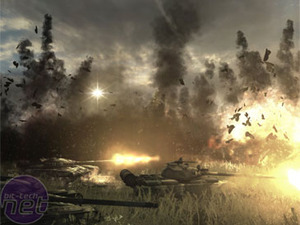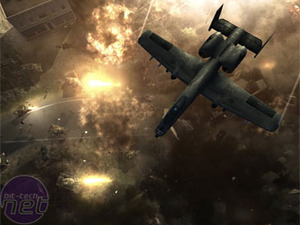
The Way It's Meant To Be Played:
After Nvidia released the somewhat ill-fated GeForce FX series of graphics cards over five years ago now, it was in a situation where it wasn’t in a dominant position in the graphics market – ATI was the performance leader and Nvidia had its work cut out. Around the same timeframe, the The Way It’s Meant To Be Played developer relations programme was started.Roy explained that Nvidia had a GPU that was all about shaders in a world that was all about textures and fill rates. Thus, Nvidia felt it was a good time to educate developers on what shaders could do for their games and to make sure that games ran as best as possible on its hardware.
Since then, TWIMTBP has expanded considerably and the support team now has more than one hundred people working on the programme. Nvidia often relocates engineers from its own support team to work in-house with development teams like Crytek, Relic and others to help them to create content that takes advantage of new features in Nvidia GPUs – right now, that new feature is DirectX 10 of course.
We asked Roy why Nvidia felt the need to have such a massive developer relations team. “At its best, PC gaming is dramatically better than console gaming, and at its worse, it’s a far worse experience than console gaming,” he said.


“Our research shows that PC gamers buy five or more games per year, and they’re always looking for good games with great content. Our aim is to stop developers from making poor console ports [which we’ve certainly witnessed in the past] and to generally help the industry. Of course, our aim is to sell more GPUs – it’s impossible to deny that – but without great PC gaming content, there is no demand for our GPUs.”
We asked Roy what he felt the TWIMTBP logo meant and what he hopes gamers will see it as. “It means is that gamers will get a great experience on Nvidia hardware, and there will be gameplay features included that you can't get on the consoles,” he answered.
Roy went onto talk about the ongoing war between publishers and artists, and that is what often limits the potential of games. “It’s important that the graphical improvements we suggest are beneficial to the gameplay,” he said. “We can’t just make a game for the high-end though, because the game’s hit ratio would be too low.”
I asked Roy to elaborate on what he meant by hit ratio; “typically, a publisher will look to sell around one million, or more, copies of a triple-A title. If the game targets a limited install base because of certain gameplay features that can only run on a high-end machine, the hit ratio is very low.”
He mentioned that publishers typically look for a hit ratio of 200-to-1, which curiously happens to line up with the publisher's sales expectations and the number of active GeForce users Roy stated earlier on. “If we target the high-end with gameplay features that only those systems have enough power to use, the game’s hit ratio may be as low as 30-to-1. Most publishers won’t agree to that kind of hit ratio.”
When he was talking about graphical effects, Roy means affects that can change the dynamics of a game. He used an example of a bridge being blown into many pieces, rendering it unusable – from a publisher’s point of view, there is no point in implementing these effects into the game if the low-end hardware can’t handle them (even after they’ve been watered down massively).

MSI MPG Velox 100R Chassis Review
October 14 2021 | 15:04










Want to comment? Please log in.